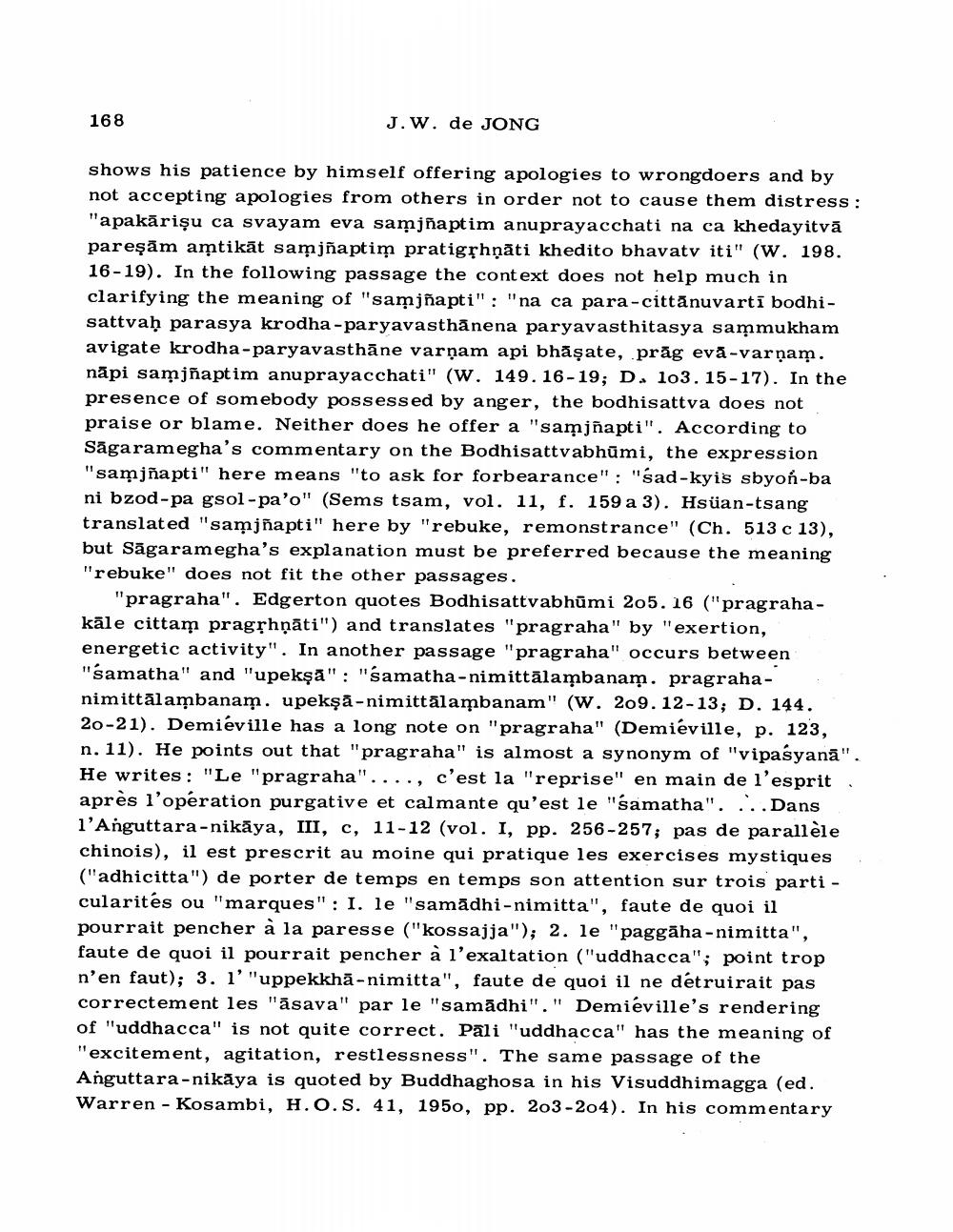________________
168
J. W. de JONG
shows his patience by himself offering apologies to wrongdoers and by not accepting apologies from others in order not to cause them distress: "apakarişu ca svayam eva samjñaptim anuprayacchati na ca khedayitva pareṣām amtikat samjñaptim pratigṛhņāti khedito bhavatv iti" (W. 198. 16-19). In the following passage the context does not help much in clarifying the meaning of "samjhapti": "na ca para-eittänuvarti bodhisattvaḥ parasya krodha-paryavasthänena paryavasthitasya sammukham avigate krodha-paryavasthāne varņam api bhāṣate, prag eva-varņam. napi samjħaptim anuprayacchati" (W. 149. 16-19; D. 103. 15-17). In the presence of somebody possessed by anger, the bodhisattva does not praise or blame. Neither does he offer a "samjhapti". According to Sāgaramegha's commentary on the Bodhisattvabhūmi, the expression "samjñapti" here means "to ask for forbearance": "sad-kyis sbyon-ba ni bzod-pa gsol-pa'o" (Sems tsam, vol. 11, f. 159 a 3). Hsuan-tsang translated "samjñapti" here by "rebuke, remonstrance" (Ch. 513 c 13), but Sagaramegha's explanation must be preferred because the meaning "rebuke" does not fit the other passages.
"pragraha". Edgerton quotes Bodhisattvabhūmi 2o5. 16 ("pragrahakāle cittam pragrhpati") and translates "pragraha" by "exertion, energetic activity". In another passage "pragraha" occurs between "samatha" and "upeksa": "Samatha-nimittälambanam. pragrahanimittālambanam. upekṣā-nimittālambanam" (W. 209. 12-13; D. 144. 20-21). Demiéville has a long note on "pragraha" (Demiéville, p. 123, n. 11). He points out that "pragraha" is almost a synonym of "vipasyanā". He writes: "Le "pragraha"...., c'est la "reprise" en main de l'esprit après l'opération purgative et calmante qu'est le "samatha". ...Dans l'Anguttara-nikaya, III, c, 11-12 (vol. I, pp. 256-257; pas de parallèle chinois), il est prescrit au moine qui pratique les exercises mystiques ("adhicitta") de porter de temps en temps son attention sur trois parti - cularités ou "marques": I. le "samadhi-nimitta", faute de quoi il pourrait pencher à la paresse ("kossajja"), 2. le "paggaha-nimitta", faute de quoi il pourrait pencher à l'exaltation ("uddhacca"; point trop n'en faut); 3. 1'"uppekkha-nimitta", faute de quoi il ne détruirait pas correctement les "asava" par le "samadhi"." Demiéville's rendering of "uddhacca" is not quite correct. Pali "uddhacca" has the meaning of "excitement, agitation, restlessness". The same passage of the Añguttara-nikaya is quoted by Buddhaghosa in his Visuddhimagga (ed.) Warren - Kosambi, H. O. S. 41, 1950, pp. 203-204). In his commentary




